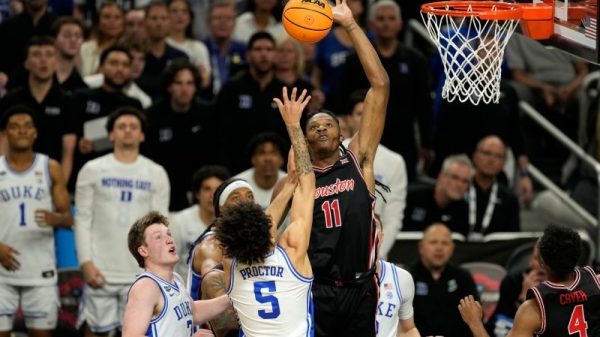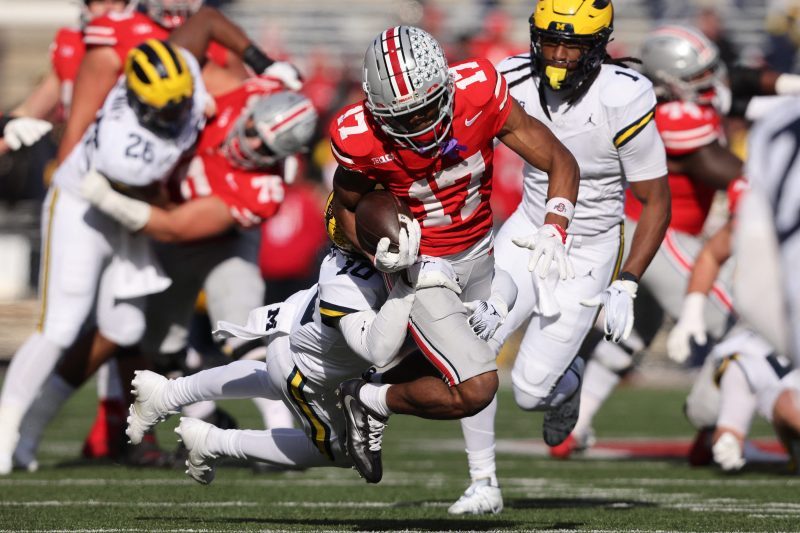The Big Ten is set to have three teams in the playoff field, with Michigan having one last chance to upset Ohio State.
The SEC faces a potential four-way tie, which could lead to a complex tiebreaker formula to decide its championship game participants.
Miami is considered the ACC’s best team but is unlikely to make the conference title game, relying on an at-large playoff bid.
Most of the hay is in the proverbial barn with just one week remaining in regular season as teams fight to make the College Football Playoff. That being the case, we’ve seen dominant narratives associated with each conference take hold during the course of the campaign.
One league is too deep, one is too top heavy, and everyone else is struggling to find a seat at the table. We’ll use this week’s missive from Overreaction HQ to address these issues in turn.
Do the narratives have merit? Are they overly simplistic or overly complicated? As always, the answer is probably something along the lines of ‘Yes, and no.”
The Big Ten’s depth problem
No matter what happens in the closing weekend, the Big Ten is going to have three teams in the playoff field. They were undoubtedly hoping for more at league headquarters, but candidates to be the fourth representative have fallen by the wayside on a weekly basis. The latest was Southern California, which earlier missed an opportunity to pick up a high-end victory at Notre Dame and likewise came up short at Oregon.
There is one last opportunity for a fourth B1G member to crash the party. On one hand, it’s a long shot, but on the other it’s a team with recent history on its side against its most loathed rival. We refer, of course, to Michigan, which will try one more time to upset the applecart by taking down Ohio State.
Strictly speaking the Buckeyes don’t need to win it. They recovered from losing to the Wolverines last year and wound up hoisting the championship trophy in the end. Realistically, however, the team, its coach and its fans will want to remove this final missing piece from their list of accomplishments once and for all.
The SEC’s tiebreaker problem
Among the many complications brought on by conference expansion in the power leagues is the often absurd number of tiebreaker scenarios that emerge when determining the championship game participants. Compared to some other leagues the SEC’s situation is fairly straightforward, but a four-way tie at the top is a possibility should Texas hand Texas A&M its first loss next week. With just two head-to-head results among the foursome, an esoteric formula weighing opponents conference win percentage will determine which teams will head to Atlanta to play in a game that, truth be told, they’d probably be better off skipping.
This was entirely predictable, of course. When a 16-team league has only eight conference games scheduled, there isn’t going to be enough overlap to produce any meaningfully understandable ways to break ties. Adding a ninth league game will help, but the real culprit in all this was the decision to abandon conference divisions. Obviously the SEC was not alone in that, but there should still be a less messy method of determining a champion.
The ACC’s Miami problem
While the ACC champ will be in the playoff, it’s quite possible its best team won’t be. If we’re being honest, Miami is the one member of the conference with a realistic chance to actually win a playoff game, but the Hurricanes are in all likelihood relegated to the at-large pool since their path to the conference title game hinges on several unlikely Week 14 outcomes, starting with losses by Virginia and SMU.
To be clear, the ‘Canes have no one to blame but themselves for being in this predicament. Their two losses had more mistakes than a first-grade piano recital. Now they need to take care of Pittsburgh on the road and hope that result along with their Week 1 win against Notre Dame are enough to impress the committee.
The Big 12’s respect problem
In the end, there might still be room for both Texas Tech and Brigham Young in the field. But whichever of them loses their expected upcoming rematch in the Big 12 title game will find itself in a crowded at-large pool that, based upon what the committee has given us thus far, is going to be quite SEC heavy. Big 12 squads have produced several out-of-conference wins against other power leagues, but most of them have been at the expense of the ACC.
First things first, of course – the Red Raiders and Cougars need to do their part next week by handling West Virginia and Central Florida, respectively. They’ll probably need a few other favorable results as well, then they must stage a good contest and hope that is enough.
The Group of Five flag-bearer problem
The so-called G5 had a clear front-runner a year ago at this time, when Boise State sent a Heisman finalist to New York City and was deemed worthy of a first-round bye. No such standard bearer has emerged from the non-power leagues this year. Tulane posted a couple Power Four wins but was completely overwhelmed by Ole Miss and routed at Texas-San Antonio. South Florida can claim an SEC win at the expense of Florida, but the Bulls didn’t fare nearly as well against Miami. North Texas has just a single loss but was trounced in that one by said Bulls and is untested against the power leagues.
What about James Madison, you say? The Dukes’ loss to Louisville hasn’t aged well given the Cardinals’ recent swoon, and the Sun Belt as a whole hasn’t been as strong as in some recent years. It will therefore likely be the American champ getting the fifth automatic berth, but whichever team that is figures to be a major underdog.





















